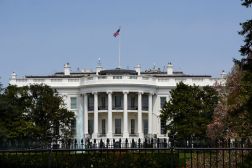Weichert makes her case for the OPM reorganization

When it comes to Margaret Weichert’s role at the Office of Personnel Management, it’s now clear that she has more than just one big job. Not only is she acting director of the agency, but she’s also acting as the marketer-in-chief for the Trump administration’s effort to reorganize it.
Weichert tended to that part of the job — steering the conversation on what the White House is planning and why — Tuesday during a roundtable discussion with reporters. She explained the “case for change” that OPM released this week — a three-page document arguing that the agency should be moved under the General Services Administration.
“Fundamentally, we believe the current structure of OPM does not meet the needs of our 21st century missions,” she said.
The proposal will essentially “lift and shift” OPM’s services — many of them being IT-heavy systems that serve the federal civilian workforce — to placement as one of the business lines within GSA. OPM would then be on par with offices like the Federal Acquisition Service (FAS) and the Public Buildings Service (PBS). What the new version of OPM within GSA will be called remains to be negotiated.
Although efficiency and structure might be on the administration’s mind, Weichert made it clear that money is a big factor, too. An upcoming reduction in OPM’s workload will come with a corresponding shrinkage to its budget, she said. The National Background Investigations Bureau (NBIB) — is moving to the Department of Defense, as mandated by the National Defense Authorization Act of 2018. NBIB currently represents 80 percent of the agency’s revolving fund — the fees or reimbursements paid by agencies for services OPM provides. The revolving fund is OPM’s largest source of funding.
The money will have a direct effect, she said, on OPM’s most pressing need: upgrading older IT systems that are slow, potentially unreliable or vulnerable to intrusions. The massive 2015 breach is still fresh in the mind of the federal workforce and OPM’s congressional overseers. President Trump’s nominee to lead OPM, Dale Cabaniss, noted during a recent confirmation hearing that she, too, was affected by the breach.
Beyond the fallout from NBIB’s move, there’s what Weichert calls a need to increase overall “operational excellence” within the federal workforce. Under the current structure, she says, OPM is too weighed down to think these kinds of big, cross-government thoughts. Some of the responsibility for that would shift to the White House Office of Management and Budget, which would add three people at its Office of Federal Procurement Policy to concentrate on the topic.
Weichert argues that the course plotted in the “case for change” document will benefit all of the agencies involved. Both GSA and OPM would benefit from “synergies” and “efficiencies” once combined, she said, and OPM employees would benefit from better tech tools though GSA.
Some of the fear surrounding the reorganization has been about what it means for the size of the OPM workforce, but Weichert said Tuesday that she is not planning any major cuts. “We need to be pro-employe through these changes or we will not get another at-bat,” she said.
Weichert isn’t blaming anyone for the current situation. “The people at OPM have done absolutely the best they can” under the circumstances, she said. But “the status quo is not sustainable.”
The real target for Weichert’s comments, of course, is Capitol Hill. In order to move forward with the reorganization, however, OPM needs legislative authorities. Weichert and team hope to introduce their “legislative fix” in the coming days, and Weichert plans to testify before lawmakers on the issue next week. She’s “hopeful,” she said, that Congress will help out. Resistance is likely to come from Democrats in the House majority, especially those with large federal workforces in their districts.
The Trump administration first floated its government reorganization plan, which includes this OPM reorganization, last summer.






